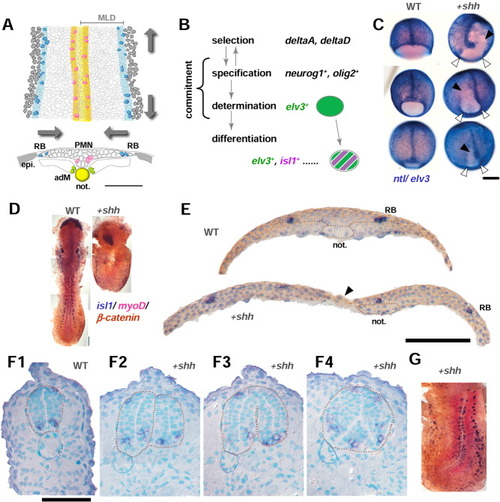
Shh overexpression affects gastrulation and neurulation. A: Medial and lateral proneural columns in the neural keel. Dorsal view (upper) and transverse section (lower) of the developing neuroectoderm to form the neural keel in the future spinal cord region (11.33-14 hpf, 4-10 somite stage). Medial proneural domains (two orange longitudinal columns in the middle of the dorsal view, upper) in which primary motoneurons (pink cells, isl1-positive) are formed, lie intervened by a single row of medial floor plate cells direct dorsal to the axial mesoderm (notochord, yellow) and appear as a medial thickenings in transverse section (lower). Both Shh and Twhh are expressed in the medial floor plate. Adaxial mesodermal cells (adM, yellow green) that give rise to future slow muscle lie adjacent to notochord and express basic helix-loop-helix (bHLH) myogenic factor, myoD, which is under positive control of Hh signalling. Lateral-most proneural columns (blue longitudinal stripes) produce Rohon-Beard sensory neurons (isl1-positive, blue cells) and foxd3-positive premigratory neural crest cells and appear as lateral thickenings in the transverse section (lower). As development progress, cells in the neuroectoderm converge toward the midline (two facing horizontal arrows) and bilateral thickenings fuse with medial structure. Mediolateral extent of the neural keel corresponds to ventrodorsal extent in the neural tube. Normal progress of this morphogenetic process requires at least in part a planar cell polarity gene, trilobite/strabismus. B: Four steps of primary neurogenesis: selection, specification, determination, and differentiation. The term commitment refers to both specification (reversible to selected state) and irreversible determination steps; hence, we call the latter process as the establishment of neuronal commitment as well. elv3 and isl1 mRNA expressions mark the establishment of neuronal commitment (determination) and the onset of differentiation process, respectively. elv3 mRNA expression persists after the onset of isl1 expression within the temporal range of our analyses during the neural keel stage. C: Gastrulae from wild-type (WT, left column) and shh mRNA-injected WT embryos (right column) were fixed at the 75%, 80%, and 90% epiboly stages (top, middle, and bottom, respectively) and overstained with ntl and elv3 to illuminate the deep cells. The animal pole is up, and the vegetal pole is down. Margin of the germ ring proceeds from animal (top) to vegetal (bottom). shh mRNA injection retarded dorsalward convergence movements at the close vicinity of the dorsal midline (black arrowhead), whereas ventral and lateral margin of the germ ring appear to move normally toward the vegetal pole (white arrowhead). Note that, in shh embryos, the notochord is received on one side of the embryo. D: Uninjected control embryos (WT) at the 9-somite stage (left) and shh embryos at the 4- to 5-somite stage (right). Both embryos are obtained from the same crossing and fixed at the same incubation time and processed to isl1(blue)/myoD(red) in situ hybridization followed by overstaining of β-catenin immunohistochemistry (dark brown). shh embryos resemble "trilobite", with short anteroposterior axis and wider mediolateral extent, with a large opening of deep cells covered with a sheet of enveloping layer (EVL). Anteriormost isl1 staining in the hatching gland rudiment (polster) underlies the forebrain in uninjected controls (left); however, in shh embryos, polster was observed underneath the prechordal plate (right). E: The same pair of embryos in D were shown in the transverse sections at the level of the fourth and fifth somite. In shh embryos (lower), two halves of neural anlage did not come to fuse medially, instead, they were tethered with a single layer of EVL (black arrowhead), in good contrast to the uninjected control (upper). Nuclei were counterstained with hematoxylin (blue). F: Transverse sections at the 25-hours postfertilization (hpf) stage of uninjected control embryo (F1) and shh embryos (F2-4). Embryos are stained with isl1 (blue) and counterstained with hematoxylin/truidine blue for nuclei (light blue). F2-4 are all obtained from the same shh embryo and set out from the anterior to posterior direction. The apical and basal surfaces of the neural tube are delineated with white and brown dotted lines, respectively. G: Asymmetric shh mRNA distribution caused curved body axis toward much wider side (affected side), suggesting convergence and concomitant extension movements as an underlying mechanism to shape the neural anlage. In C and D, different focuses of planes are merged for presentation. Orientation in D and G, anterior is up; in E and F, dorsal is up; epi, epidermis; not., notochord; MLD, mediolateral distance. Scale bars = 200 μm in C, 50 μm in E,F.
|

